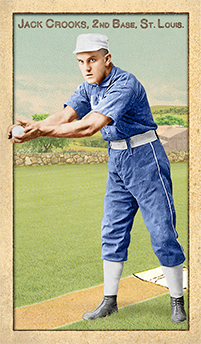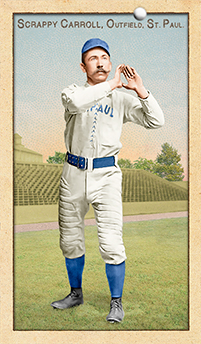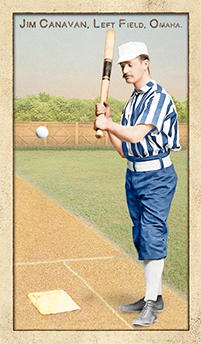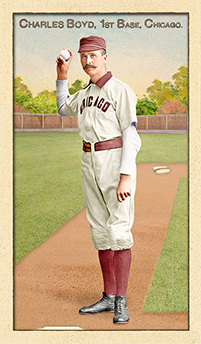
- Series: Beginnings: 1880's
- City: St. Louis
- Team: Whites (WA)
- League: Western Association
Charles John Crooks (1865-1918) became the first player in organized ball known to have hit four home runs in a game, accomplishing the feat for the Omaha Omahogs in 1889. The whole Western League had struggled to stay afloat that year and the team’s sale of Crooks to the American Association’s Columbus Colts that summer enabled them to make a profit (Omaha got $1750 for their outfielder and netted $1000 for the year). The four homers proved his strength but it was Crooks’ uncanny ability to draw walks that made him most valuable. He remains among a handful of players to record more bases on balls than games in a season, ranking him with the likes of Ted Williams, the Mick and the Babe. With a lifetime OBP of .408 and a BA of .237, Jack is in the top-ten highest ratio of the two.
- Despite Jack’s sabermetric value, the 1890 Colts were his only winning team in an 8-year career
- Jack cut short his baseball career after finding success as a cigar salesman

- Series: Beginnings: 1880's
- City: Chicago
- Team: Maroons
- League: Western Association
John T. (or F.) Crogan is another of those tantalizing “mystery men” of the Old Judge card era. Many of their subjects were photographed in anticipation of a major league career that never happened. In this case, Jack was posed for five images in the OJ 1888 series. He wears the uniform of the Chicago Maroons of the Western Association as depicted in the Miller/Gonsowski/Masson definitive OJ text with middle initial T. whereas Baseball-Reference.com has him with F. Prior to his brief time with the Maroons (21 games, .188 BA) Jack was with Wheeling in ’87, apparently his first year in the minors. He went on to play in the Texas and Tri-State Leagues before finishing up with Davenport of the Illinois-Iowa League in 1891. The rest of this would-be big leaguer’s exploits are lost to history.
- The Miller compilation shows a possible alternate surname spelling of Croghan
- The only batting pose available shows Jack in a left-handed stance

- Series: Beginnings: 1880's
- City: St. Paul
- Team: Apostles
- League: Western Association
John E. Carroll (1860-1942) began in MLB with the Union Association’s St. Paul White Caps in September 1884. The outfielder played in all nine games of the franchise’s only “season” going 3 for 31 with five errors. In ‘85, after stints with two minor-league clubs, Scrappy got a chance with the Buffalo Bisons of the NL. His .097 average fell when he went 3 for 41 in 13 games. Following time with the Utica Pent Ups, Carroll got his last chance in the majors with Cleveland’s Blues of the AA where he hit .199 in 57 games. His career average of .171 sent Scrappy permanently back to the minors. Old Judge misidentified one of his poses as being a Chicago Colts’ player, confusing him with Cliff Carroll.
- Carroll debuted in Cleveland on the city’s first Sunday game, August 3, 1887. He may or may not have innovated sunglasses, but he was noted for catching the attention of “the kranks” for donning “colored spectacles” one sunny day
- As so many before and since, Carroll had much more success in the minors, once even leading the Western League in home runs

- Series: Beginnings: 1880's
- City: Omaha
- Team: Omahogs
- League: Western Association
James Edward Canavan (1866-1949) began in the major leagues during the 1891 season, playing more games for “King” Kelly’s Cincinnati “Killers” (aka “Porkers”) than any other team member. As the shortstop, Jim didn’t have a great average (.228) but he drove in the most runs, proving his clutch nature. Later that year, after the Killers were dissolved, Canavan and four others moved to Milwaukee. Canavan began and ended his pro-ball career in his native New England, beginning in New Hampshire and closing out his time in hometown New Bedford, playing and managing for the Whalers. After his rookie year, Jim played for Cap Anson’s Chicago Colts, then returned to the Queen City with the Reds before ending his big league tenure as a Brooklyn Bridegroom in 1897.
- Canavan piloted his New Haven Blues to the Connecticut State League pennant in 1902
- Captured here by the Old Judge photographers while with Omaha in 1889, Jim had a good year: 10 HRs, 93 Runs & 75 SBs in just 116 games
- Jim's uniform color on this card was changed in February, 2017 from red/white/black to blue/white/blue to reflect recent reliable research by Craig Brown & friends at Threads of Our Game. Five cards had been previously released featuring a red/white/black uniform.

- Series: Beginnings: 1880's
- City: Chicago
- Team: Maroons
- League: Western Association
Charles Boyd is another of the Old Judge mystery men. He appears in the 1888 card series in three poses in the uniform of the Chicago Maroons of the Western Association. He is right-handed and identified as a first-baseman. Miller, Gonsowski and Masson, in their Old Judge compendium, relate a reference from the Feb 18, 1888 Sporting News reporting the signing of Charles, of Sheffield IL, by the Maroons. A March 31 article predicted this fleet-footed (“he can beat Billy Sunday”) slugger would join the club by April 15. We find no record of Boyd making the Maroons or any other minor league team. There is a cryptic reference to a “Boyd” on the roster of the Danville, IL Browns in 1888 but there is nothing else to identify that player.
- The Old Baseball Cards website lists the Boyd card as depicting “Jake” Boyd while the Goodwin editors have him as “Charles” with the Sporting News items as support
- As ever with these “ghosts” from the early decades of the game, Ars Longa welcomes any leads on identifying Mr. Boyd




